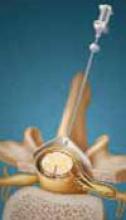Let’s use breech presentations as an analogy. After a multicenter randomized trial of vaginal birth versus elective cesarean showed a clear benefit for the latter, the Society of Obstetricians and Gynecologists of Canada sent a letter to its members advising them to deliver all breech infants by cesarean “to minimize risks.”5 Despite that compelling recommendation, I believe few veteran obstetricians would deny a request for vaginal delivery from a multipara who previously had experienced an uneventful spontaneous delivery of a 4,500 g infant, provided the current breech-presenting baby had an estimated weight of less than 4,000 g at term. Why force a woman to undergo cesarean delivery if she accepts a 1% risk of devastating fetal injury with vaginal birth? Conversely, why force a primipara to deliver vaginally when she has been well informed of her options and decides that elective cesarean is best? Although some physicians and hospitals have gotten the courts to override the mother’s wishes, it is probably just a matter of time before they and the local authorities are successfully sued in federal court for violating her civil rights.
TABLE 1
Risk of fetal cerebral hemorrhage, by mode of delivery
| MODE OF DELIVERY | RISK |
|---|---|
| Cesarean with no labor | 1:2,750 |
| Spontaneous vaginal delivery | 1:1,900 |
| Cesarean in labor, with no attempt at vaginal delivery | 1:954 |
| Vacuum-assisted vaginal delivery | 1:860 |
| Forceps-assisted vaginal delivery | 1:664 |
| Cesarean after failed operative vaginal delivery | 1:334 |
| SOURCE: Towner D, Castro MA, Eby-Wilkens E, Gilbert WM. Effect of mode of delivery in nulliparous women on neonatal intracranial injury. N Engl J Med. 1999;341(23):1709-1714. | |
The increasing safety of elective cesarean
In the past, when prenatal care was inadequate, elective cesarean or induction of labor often resulted in the delivery of premature infants. Today, good care with early ultrasound can eliminate that threat.
When I trained as a physician, anesthesia for cesarean section carried significant risk. Today, it is hard to argue that a 45-minute epidural during cesarean section poses more risks than the typically far longer periods of epidurals administered during vaginal births. In the current environment, who would deny a woman epidural anesthesia for vaginal birth for the absolutely correct reason that it adds risk?6 Nor do third-party payers refuse to cover anesthesia, despite the fact that there is no “medical” indication for it. Pain relief is now considered a gravida’s right.
Most women now prefer epidural anesthesia to the pains of labor and vaginal birth.
In the United Kingdom and many other countries with good prenatal care, thromboembolism is the leading cause of maternal mortality. Although the risk of thromboembolism increases with cesarean section, it can be markedly reduced by using low-molecular-weight heparin for patients with identifiable risk factors such as obesity, smoking, immobility, and a personal or family history of deep venous thrombosis (DVT). In addition, testing for the Leiden gene (gene 20210A) and other thrombophilic factors could identify patients at highest risk.
For the fetus, the downside of elective cesarean is a small increase in mild respiratory problems, which usually are transient with good pediatric care. Still, we can hardly fault our pediatric colleagues for protesting that elective cesarean creates more work for them. It does do that, as risks and benefits are apportioned differently between mother and baby. Nevertheless, infants face the highest risk when attempted vaginal birth ends with any kind of operative delivery, be it forceps, vacuum extraction, or cesarean. To quote the FIGO ethics committee once more: “There is no hard evidence on the relative risks and benefits of term cesarean delivery for non-medical reasons as compared with vaginal delivery.”2 Nor are we likely to ever see a prospective randomized study of elective cesarean at term versus attempted vaginal delivery.
I was recently surprised to learn that in Shanghai, Beijing, and other major cities in China, the overall cesarean delivery rate is 50%, with individual hospitals ranging from 35% to 70%. In Taiwan, the rate of cesarean delivery ranges from 30% to 50%. In contrast to the United States, where physicians and patients often creatively find a “medical” indication to placate payers or quality-assurance committees, the Chinese openly identify the major indication for cesarean as “social.”
Since the typical Chinese woman has only 1 baby—possibly 2—she tends to seek early and consistent prenatal care and to select elective cesarean at term, believing these actions offer maximum benefit to both her and the infant. While there are no data refuting this belief, we also lack good data substantiating it. Nor do we have reliable evidence that cesarean rates are useful indicators of quality of care. We use them because they are easy to obtain. However, in the emerging world of evidence-based medicine, they lack validity.



